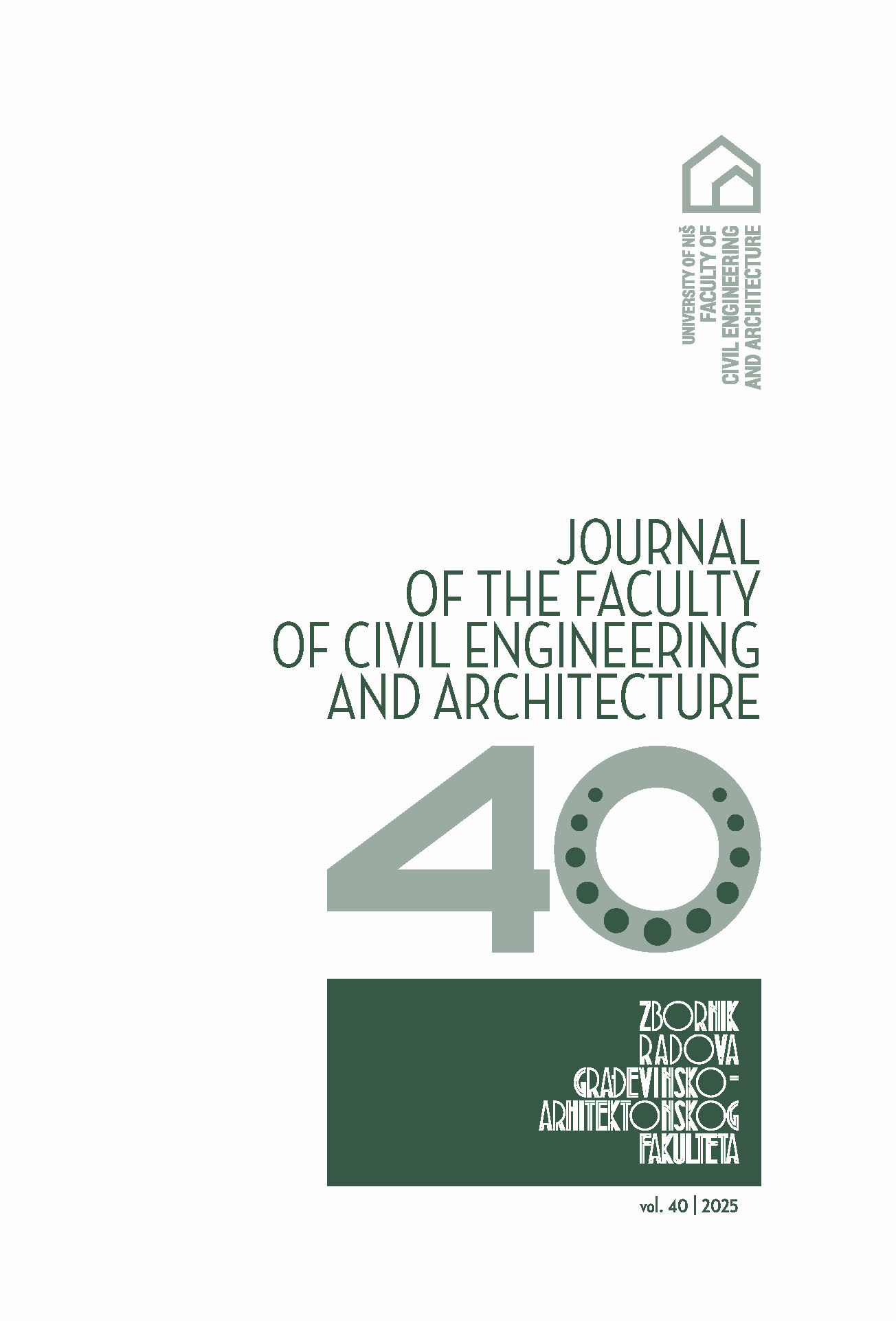HOW SPATIAL CONFIGURATION INFLUENCES PUPILS’ INFORMAL SOCIAL ACTIVITIES: A SPACE SYNTAX ANALYSIS OF AN ELEMENTARY SCHOOL IN NIŠ
Social interaction is shaped by a dynamic interplay between individuals and their physical surroundings, with each continuously influencing the other. From early childhood onward, individuals engage in diverse social situations, and peer interactions within school environments play a critical role in their development. Therefore, schools are recogn...
By Vojislav Nikolic, Milan Tanić, Danica Stanković, Slaviša Kondić
ESTIMATION OF EVAPORATION IN URBAN CONDITIONS
Reliable method for estimating pan evaporation is essential for modelling precipitation, different water balance studies and water management, especially in conditions with prominent climatic changes, such are urban conditions. Four empirical equations (Stephens and Stewart, Griffiths, Kohler-Nordenson-Fox and Linacre 1994) are used for modelling p...
By Mladen Milanovic, Dragan Milicevic, Slavisa Trajkovic
NATURE-BASED SOLUTIONS IN REGENERATION OF PUBLIC OPEN SPACE: CHALLENGES AND PROSPECTS OF IMPLEMENTATION IN THE CITY OF NIŠ
Nature-based Solutions (NbS) are increasingly prioritized in contemporary urban planning of residential areas, as they offer sustainable and resilient responses to environmental and social challenges, by integrating nature to enhance climate adaptation, biodiversity, and human well-being. Given their crucial role in enhancing public open space (POS...
By Milena Dinić Branković, Danijela Milanović, Jelena Đekić, Milica Ljubenović, Milica Igic
THE METHODOLOGY OF DETERMINING THE LOAD-BEARING CAPACITY OF HIGH PROFILE SHEETS USING THE EXPERIMENTAL METHOD
In civil engineering, high-profile sheets (HPS) are widely used. They are used as loadbearing elements in a system of stacked roofs, for covering large-span structures or as permanent formwork when casting concrete slabs. Determining the load-bearing capacity of these elements is a complex task, and designers take this data from the manufacturer's ...
By Ivan Nešović, Miloš Milić, Todor Vacev, Andrija Zorić, Nikola Janković
APPLICATION OF BRISE-SOLEIL IN ARCHITECTURE: A CASE STUDY OF A NEWLY DESIGNED RESIDENTIAL NEIGHBORHOOD IN BAOŠIĆI CONSIDERING BIOCLIMATIC AND URBAN PLANNING PARAMETERS
Global warming and rising energy demand make brise-soleil systems increasingly important in energy-efficient cooling and reducing carbon emissions in warm climates. This study examines a newly designed residential neighborhood in Baošići, Montenegro, characterized by a Mediterranean climate with hot, dry summers and mild winters. The effecti...
By Dušan Ranđelović, Miomir Vasov, Anđela Bogdanović, Vladan Jovanović
CHALLENGES AND OPPORTUNITIES IN THE REDEVELOPMENT OF PUBLIC OPEN SPACE WITHIN MULTI-FAMILY HOUSING ESTATES IN POST-SOCIALIST CZECH REPUBLIC
This research explores the evolution of public open spaces (POS) in large housing estates (LHE) within the post-socialist context, using the Czech Republic as example. The study investigates the challenges and opportunities associated with the redevelopment of POS, considering the impacts of privatization, socio-economic transformations, and urban ...
By Mihailo Mitković, Milica Igic
PROBABILISTIC ESTIMATION OF LIFE-CYCLE CHLORIDE-INDUCED CORROSION
Coastal bridges constitute critical components for the transportation in offshore areas, and thus their serviceability and safety against hazard such as earthquakes need to be ensured in a life-cycle perspective. However, coastal bridges are confronted with significant corrosion that results in degradation effects mainly on concrete piers. This can...
By Jiabin Liu, Heng Mei, Andrija Zorić
ANALYSIS OF SURFACE DEFORMATIONS DURING EXCAVATION OF A SMALL OVERBURDEN TUNNEL IN WEAK ROCK MASSES
Excavation of tunnels with a small overburden inevitably implies surface settlements, especially when they are carried out in soft soil or weak rock masses. Subsidence becomes a critical aspect when the construction of tunnels is realized in narrower urban areas, directly below occupied residential buildings. Taking as an example the Kobilja Glava ...
By Ekrem Bektašević, Satko Filipović, Kemal Gutić, Džemal Hodžić, Namik Musa
SOME DEEP FREEZE STORAGE HEAT TRANSFER PROBLEMS
The paper discusses the specific problems that occur with deep freeze storages, from the aspect of building physics. A special review is given of the phenomenon of soil stability, i.e. soil bearing capacity, in the context of soil freezing, deformations of the floor structure, and functional disorders in the interior of deep freeze stores.A case fr...
By Aleksandar Rajčić
THE COST-BENEFIT ANALYSIS OF WASTEWATER TREATMENT PLANT DISPOSITION - THE MUNICIPALITY OF PIROT CASE STUDY
Because of the significance of the river Nišava for the city, the Municipality of Pirot has adopted a water protection concept for the city of Pirot and several smaller settlements located upstream along the Nišava River (Krupac, Veliko Selo, Veliki Jovanovac, Mali Jovanovac, Trnjana, Izvor). The wastewater treatment would be done eit...
By Marija Milićević, Aleksandra Ilić






